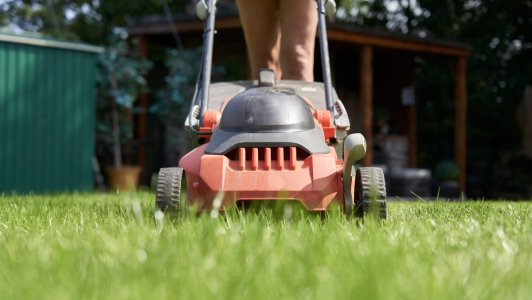Rising costs leave homeowners searching for ways to keep lawns green without breaking the bank
- Replies 0
For many homeowners, nothing beats the sight of a lush, healthy yard.
But in recent years, the price of maintaining that green carpet has climbed sharply, and the bill can vary wildly depending on where you live.
In some areas, the cost of watering a lawn for a single season is enough to leave residents in shock.
Yet, there are practical ways to cut expenses—without sacrificing curb appeal.
Analysts considered water rates, average yard sizes, drought likelihood, and the amount of water lawns typically require.

The 10 most expensive cities for lawn watering are:
As a result, many residents have turned to xeriscaping, replacing water-hungry grass with stones, cacti, and hardy plants that need far less upkeep.
By contrast, cities in the Midwest and Northeast—such as Akron, Boston, Syracuse, and Ann Arbor—ranked among the cheapest.
Abundant rainfall, milder summers, and less thirsty turf help keep their watering costs low.
Also read: Raking your leaves could be damaging your yard: Surprising reasons it's hurting your yard!
Some cities have even introduced stricter watering limits—or banned decorative turf altogether—in an effort to preserve supplies.
1. Adjust watering with the seasons
Grass needs different amounts of water at different times of year. Irrigation expert Dr. R. Troy Peters notes that many people overwater during cooler months and underwater during peak summer heat.
2. Skip daily watering
Most soils can store about an inch of water in the root zone, lasting from four days to three weeks depending on the climate.
Deep, infrequent watering encourages stronger root growth and greater drought resistance.
3. Use shorter cycles
Landscape irrigation specialist Charles Swanson suggests splitting watering into two or three shorter sessions.
This allows moisture to soak in, limiting runoff and strengthening roots.
4. Maintain your sprinkler system
Leaks, broken heads, or misaligned nozzles can waste large amounts of water.
Checking for these issues—and making sure the water pressure isn’t too high—can prevent costly losses.
5. Upgrade to smart technology
Weather-based irrigation controllers and soil moisture sensors automatically adjust watering schedules, ensuring you only use what’s needed.
6. Accept temporary browning
Grass naturally goes dormant in extreme heat or drought.
Letting it rest can save substantial amounts of water, with most lawns bouncing back quickly once conditions improve.
7. Consider drought-friendly landscaping
In high-cost areas, replacing sections of grass with native plants, xeriscaping, or decorative gravel can slash water use dramatically.
Also read: Is your lawn mower putting you at risk? Nearly 40,000 mowers are being recalled
8. Mulch and mow with care
Mulch helps retain moisture in garden beds, while longer grass blades shield soil from evaporation.
9. Water during cooler hours
Morning or evening watering reduces evaporation, allowing more water to reach the roots.
10. Harvest rainwater
Where permitted, collecting runoff in barrels provides a free water source for plants and flower beds.
Whether you live in a high-cost, drought-prone state or a region blessed with rain, small changes can make a big difference in your lawn-care expenses.
By rethinking your watering habits and landscaping choices, you can keep your yard looking great while protecting both your budget and the environment.
Read next: Slash your bills instantly with these 60 genius tips you wish you knew sooner!

Have you made changes to cut your lawn-care costs? Do you use smart irrigation tools or alternative landscaping? We’d love to hear your experiences and tips in the comments.
But in recent years, the price of maintaining that green carpet has climbed sharply, and the bill can vary wildly depending on where you live.
In some areas, the cost of watering a lawn for a single season is enough to leave residents in shock.
Yet, there are practical ways to cut expenses—without sacrificing curb appeal.
Where watering a lawn drains the most from your wallet
A recent nationwide review of nearly 500 major cities revealed that certain regions face significantly higher watering costs.Analysts considered water rates, average yard sizes, drought likelihood, and the amount of water lawns typically require.

Soaring costs leave homeowners searching for ways to keep lawns green without breaking the bank. Image Source: Charlotte Cowell / Unsplash
The 10 most expensive cities for lawn watering are:
- Buckeye, Arizona
- Goodyear, Arizona
- Brownsville, Texas
- Yuma, Arizona
- Tucson, Arizona
- Surprise, Arizona
- Mission, Texas
- Avondale, Arizona
- Glendale, Arizona
- Gilbert, Arizona
As a result, many residents have turned to xeriscaping, replacing water-hungry grass with stones, cacti, and hardy plants that need far less upkeep.
By contrast, cities in the Midwest and Northeast—such as Akron, Boston, Syracuse, and Ann Arbor—ranked among the cheapest.
Abundant rainfall, milder summers, and less thirsty turf help keep their watering costs low.
Also read: Raking your leaves could be damaging your yard: Surprising reasons it's hurting your yard!
Why prices keep rising
The increase isn’t driven by climate alone. Aging infrastructure, dwindling reservoirs, and growing demand are pushing water rates upward across the country.Some cities have even introduced stricter watering limits—or banned decorative turf altogether—in an effort to preserve supplies.
Tips to save water and money
Experts recommend a few easy adjustments to lower costs while maintaining a healthy yard.1. Adjust watering with the seasons
Grass needs different amounts of water at different times of year. Irrigation expert Dr. R. Troy Peters notes that many people overwater during cooler months and underwater during peak summer heat.
2. Skip daily watering
Most soils can store about an inch of water in the root zone, lasting from four days to three weeks depending on the climate.
Deep, infrequent watering encourages stronger root growth and greater drought resistance.
3. Use shorter cycles
Landscape irrigation specialist Charles Swanson suggests splitting watering into two or three shorter sessions.
This allows moisture to soak in, limiting runoff and strengthening roots.
4. Maintain your sprinkler system
Leaks, broken heads, or misaligned nozzles can waste large amounts of water.
Checking for these issues—and making sure the water pressure isn’t too high—can prevent costly losses.
5. Upgrade to smart technology
Weather-based irrigation controllers and soil moisture sensors automatically adjust watering schedules, ensuring you only use what’s needed.
6. Accept temporary browning
Grass naturally goes dormant in extreme heat or drought.
Letting it rest can save substantial amounts of water, with most lawns bouncing back quickly once conditions improve.
7. Consider drought-friendly landscaping
In high-cost areas, replacing sections of grass with native plants, xeriscaping, or decorative gravel can slash water use dramatically.
Also read: Is your lawn mower putting you at risk? Nearly 40,000 mowers are being recalled
8. Mulch and mow with care
Mulch helps retain moisture in garden beds, while longer grass blades shield soil from evaporation.
9. Water during cooler hours
Morning or evening watering reduces evaporation, allowing more water to reach the roots.
10. Harvest rainwater
Where permitted, collecting runoff in barrels provides a free water source for plants and flower beds.
Whether you live in a high-cost, drought-prone state or a region blessed with rain, small changes can make a big difference in your lawn-care expenses.
By rethinking your watering habits and landscaping choices, you can keep your yard looking great while protecting both your budget and the environment.
Read next: Slash your bills instantly with these 60 genius tips you wish you knew sooner!
Key Takeaways
- Arizona dominates the list of the most expensive cities for lawn watering, with its dry climate, high heat, and costly water prompting many residents to switch to drought-tolerant landscaping.
- Experts stress the importance of seasonal watering adjustments, deep but infrequent irrigation, and shorter watering cycles to conserve water.
- Regular sprinkler maintenance, proper water pressure, and smart irrigation technology can prevent waste and lower bills.
- Allowing grass to go dormant in tough conditions and replacing some areas with xeriscaping or native plants can save significant amounts of water.






